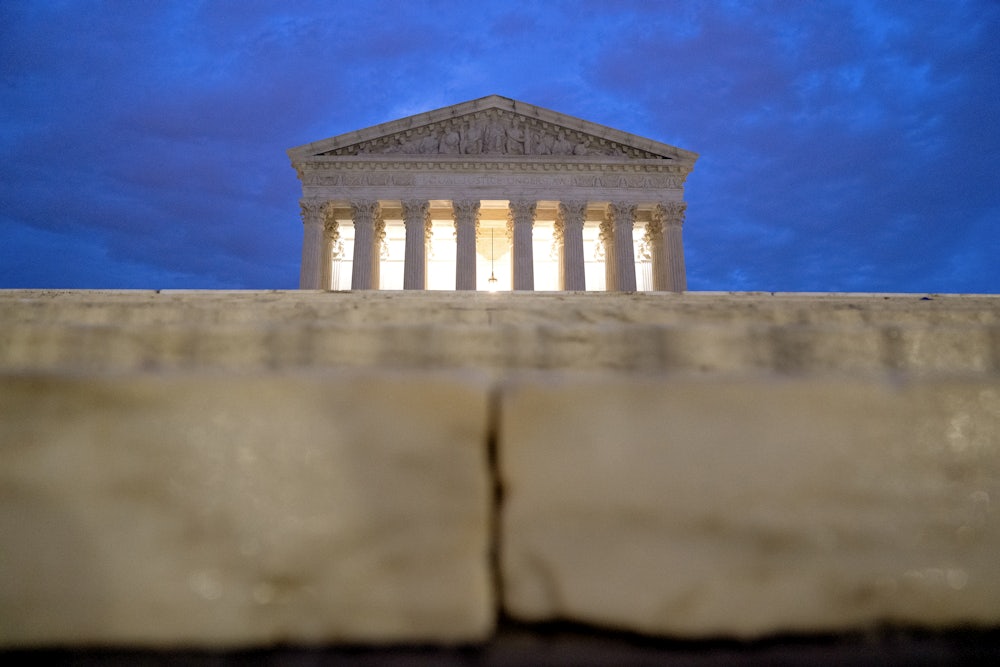The Supreme Court’s October 2020 term wraps up this week, and it wasn’t as bad as some liberals may have had reason to fear. This has led some observers to question if the court is as conservative as previously assumed. Conservative and liberal are hazy, elastic terms in everyday politics, so some allowances can be made. These terms are even less useful in the context of the Supreme Court, where the justices’ judicial philosophies don’t always reflect America’s partisan divides. But by any defensible standard, the Supreme Court’s conservative majority is secure, if not fully operational.
According to preliminary statistics by SCOTUSblog, all six of the court’s conservative justices were part of majority rulings more often than their liberal colleagues. Leading the pack was Justice Brett Kavanaugh, who found himself in 97 percent of the court’s majorities this term. On the liberal side, Justices Elena Kagan and Stephen Breyer each found themselves in the majority 80 percent of the time, and Justice Sonia Sotomayor trailed at 72 percent. (All statistics in this article exclude Brnovich v. Democratic National Committee and Americans for Prosperity Foundation v. Bonta, which haven’t yet been released.)
Though some of the rulings had unpredictable coalitions, there is still evidence of a strong ideological split among the justices. Justice Amy Coney Barrett voted with her conservative colleagues between 94 percent (Kavanaugh) and 84 percent (Justice Samuel Alito) of the time. By comparison, she voted with Elena Kagan 76 percent of the time, with Stephen Breyer 71 percent of the time, and with Sonia Sotomayor just 65 percent of the time. Barrett and Kavanaugh were the closest pair of justices on the court this term, followed closely by Chief Justice John Roberts and Kavanaugh at 93 percent.
In recent weeks, these shifting coalitions have given rise to the notion that the 6–3 split is really a 3–3–3 split, with Roberts, Kavanaugh, and Barrett at the court’s center and the court’s liberals and conservatives revolving around them. It’s an elegant model—and a flawed one. For one, a justice’s first year is an imperfect indicator of their long-term voting patterns. It’s exceedingly unlikely that Barrett will end up like Justice David Souter, who drifted away from the conservatives to become a reliable member of the court’s liberal wing. But as she becomes more familiar with the court’s dynamics, and as Supreme Court litigants become more familiar with how she approaches cases, some drift could happen in either direction.
Another problem with the 3–3–3 model is that it doesn’t accurately capture the relationships on the court’s right wing. Alito voted with Roberts (83 percent) roughly as often as he voted with Clarence Thomas (82 percent). Justice Neil Gorsuch would almost qualify as a member of the center as well, since he voted with Kavanaugh and Barrett more often than anyone else, at 89 and 90 percent respectively. But he voted with Roberts only 82 percent of the time, far less often than with any of his other conservative colleagues. Half of the court’s conservative bloc has only joined the court in the last five years, and to a certain degree, they’re still figuring each other out.
Last term, it was Roberts who firmly controlled the court’s direction and the outcome of cases. The chief justice was in the majority in 97 percent of cases at the time and cast the deciding vote in 13 of the court’s fourteen 5–4 decisions that term. That figure dropped to a slightly more humble 90 percent this term. But there are signs that Roberts’s influence and moderation continues to shape the court’s results. Among the most striking figures of the court’s most recent term is that Roberts voted with Breyer and Kagan slightly more often than he voted with Clarence Thomas, the dean of the court’s conservative wing.
Some of the justices publicly reject the idea that they’re divided into neat ideological blocs. “We agree more than you think,” Breyer explained in a National Constitution Center podcast earlier this month. “I mean, we agree almost half the time, we’re unanimous and the five-fours are about, I don’t know, 20 percent, 25 percent, 15 percent, depending on the year. And it’s not the same five and the same four.” In literal terms, Breyer’s analysis is correct. A unanimous Supreme Court decided a plurality of cases in the 2019 term, and even the most divided justices of the 2020 term—Sotomayor and Alito—still found themselves voting together 57 percent of the time.
But in a more practical sense, his depiction is flat-out wrong. Occasionally there are major cases that result in 9–0 rulings: This term’s cross-ideological antitrust ruling against the NCAA is a classic example. But many of the court’s unanimous decisions involve arcane legal issues or simply don’t affect most Americans’ day-to-day lives. The public generally won’t notice rulings on how ERISA plans interact with some state laws or whether a plaintiff has standing to challenge Delaware’s judicial-balance requirement. But they do feel the effects of 5–4 decisions on abortion rights, gun ownership, and other major political issues. And while not all of those decisions fall along the expected ideological lines, enough of them do to make it a valid framework for understanding the court’s actions.
That said, describing a case as a “conservative victory” or a “liberal victory” can often oversimplify things. There are clear conservative victories: the 6–3 ruling in Cedar Point Nursery v. Hassid earlier this month that made it easier for farm owners in California to obstruct union organizing efforts on their property. And there are clear liberal victories, such as the Obergefell v. Hodges decision six years ago that found a constitutional right to marriage equality. But not every case or outcome falls so neatly along the prevailing political lines.
Consider this year’s two most high-profile rulings. In California v. Texas, the Supreme Court rejected a GOP-led bid to strike down the entire Affordable Care Act on a bad-faith technicality. Most observers expect this to be the last existential legal fight over the landmark health care law. In Fulton v. City of Philadelphia, the justices sided with a Catholic foster agency on exceedingly narrow grounds, once again avoiding the broader question of whether religious freedom claims outweigh laws that protect gay and transgender Americans from discrimination. On paper, both seem like clear victories for liberal causes and interests.
But the reality is less straightforward. California v. Texas was the product of aggressive jurisdiction-shopping by right-wing legal activists who managed to get an extremely dubious legal argument heard by a highly sympathetic federal judge in Texas. A 7–2 majority brushed it aside on standing grounds. In Fulton, the plaintiffs sought not only to prevail against the city but also to overturn Employment Division v. Smith, a landmark Supreme Court ruling that limits Free Exercise Clause claims. The court only gave them some of what they wanted. These are not cases where liberals started a fight and won, but rather cases where conservatives started a fight and (mostly) lost.
Conservative overreach is a persistent theme behind most of the major liberal “victories” at the high court in recent years. In the court’s two most recent abortion-related rulings, in 2016 and 2020, four liberals and one conservative justice—Anthony Kennedy and John Roberts, respectively—narrowly preserved the legal status quo for abortion clinics in states that sought to shut them down. In 2016, Kennedy also joined with the court’s liberals to rule in favor of the University of Texas’s race-conscious admissions program in a case brought by right-wing legal groups. In both cases, liberals fended off conservative bids to upend settled law.
That brings us to one of the most underappreciated factors behind a court’s ideological makeup: the kinds of cases that the justices decide to hear in the first place. Advocates from across the ideological spectrum closely follow how the justices decide certain cases and try to anticipate how they would rule on certain issues. When those expectations line up, as they did with gay rights activists and Kennedy over the last decade, major changes in constitutional law can occur.
Fulton, by comparison, is a classic example of when those expectations don’t line up with the Supreme Court’s reality. As I noted last year, there was good reason to believe the court would overturn Smith. Four of the court’s conservatives had effectively signaled that they would vote to do so in a minor written opinion, and even if Roberts wasn’t on board, Barrett’s addition was seen as a promising sign. But she instead voted not to do so this time, writing in a concurring opinion with Kavanaugh that she was unpersuaded by the constitutional and practical arguments and didn’t have a clear sense of what should replace it. Conservative legal activists will spend the summer deciding how best to answer those concerns in future litigation.
To reduce the justices to their labels can also flatten their individual quirks. In his time, Scalia took a more expansive approach to the Fourth Amendment than some of his colleagues on the right. Gorsuch has written multiple times about America’s duty to live up to its promises to Native American tribes, setting him apart on an underappreciated area of the law at the high court. (His ruling in Bostock v. Clayton County last term suggests he may not be reflexively opposed to legal protections for gay and transgender Americans.) Thomas’s eclectic approach to constitutional law often cuts against liberal interests but also occasionally intersects with them: He has called into question the reasoning behind qualified immunity and recently suggested that some federal bans on marijuana are no longer constitutionally tenable.
But there are still clear trends in how the court’s conservative majority hears and decides cases. Religious freedom claims are generally favored by the court unless they involve Muslims, death-row prisoners, or both. Class-action lawsuits are viewed skeptically by a court that has sought to limit them on multiple fronts. Long-standing precedents and well-established rules that strengthen unions and help workers organize are often disfavored. Death-row prisoners are treated with skepticism at best and hostility at worst, with their claims dismissed as bad-faith impediments to a state’s right to execute. Constraining the administrative state and bolstering executive power are frequent favorites.
There are strong reasons to believe a six-justice conservative majority will broaden its horizons even further in the coming years. Gun rights advocates will press the court to embrace a broader reading of the Second Amendment, one that could invalidate state and local restrictions across the country. Opponents of affirmative action in higher education recently asked the justices to review a major challenge to Harvard’s admissions policies. And the Supreme Court has already docketed its most highly anticipated case in years for next fall: Dobbs v. Jackson Women’s Health Organization, where the justices could reverse a half-century of abortion rights precedents.
I won’t begrudge liberals for breathing a sigh of relief that this term wasn’t worse for them. With a putative supermajority on the high court, it’s also hard to blame conservatives for wondering why they’re not doing better. It’s possible that the court continues to hand out half-victories and not-quite-defeats for the foreseeable future. But when it comes to whether the Supreme Court is really that conservative, the best answer can be summed up in two words: Keep watching.








